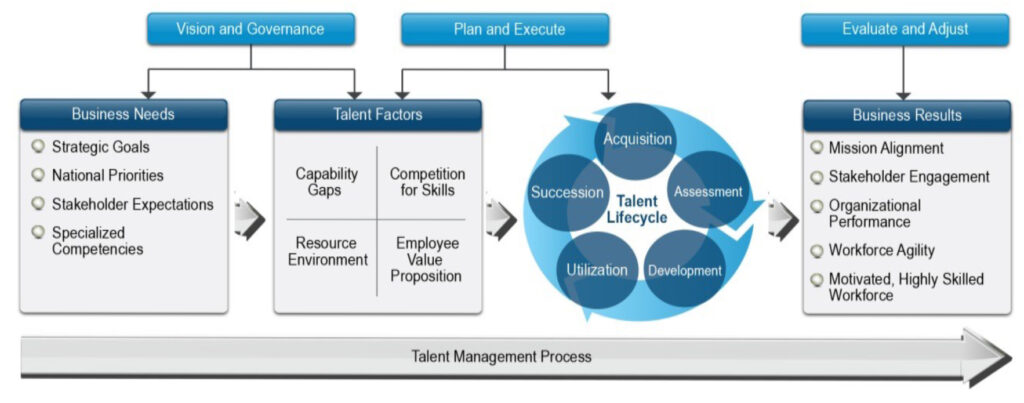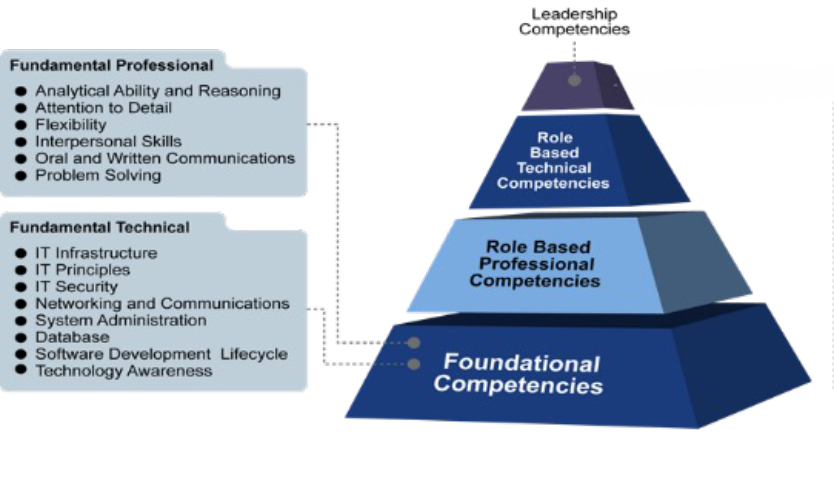
Written By

Practical Approaches to Meet the Federal Mission
By Mike Vajda, Sharon Ginley, and Michael Rogers, PhD
Across the federal landscape, agencies face significant change management challenges. Senior leadership transitions bring far-reaching expectations, including shifting missions and priorities, resource reductions, and demands for greater efficiency and productivity. At the same time, the public expects essential services to be delivered seamlessly. To meet these demands, federal leaders must adopt a strategic, adaptable, mission-focused, and workforce-centric approach.
Government contractors can help their federal partners by providing project management expertise coupled with practical, executable solutions. This involves bringing proven tools and strategies to optimize organizational structures, streamline business processes, and strengthen workforce competencies. This article explores effective approaches to assess organizational and workforce capacity, improve operational efficiency, and implement mission-driven strategies needed to achieve goals in a resource-constrained environment.
Strengthen Strategic Planning & Assessment
Effective strategic planning begins with clearly defining and aligning mission and priorities to ensure resources are allocated efficiently. Organizations should communicate goals clearly and focus on high-impact projects that deliver the most value to the mission and the public while streamlining or eliminating lower-priority tasks. Conducting an organizational assessment that leverages analytics to assess program effectiveness and guide resource allocation supports sound strategic planning and decision making. Contractors can apply project management expertise to help federal sponsors design and implement a structured approach to conduct an effective assessment.
2. Gather Stakeholder Input
Design surveys, interview guides, and focus groups to engage leadership, employees, and external partners and gather diverse perspectives on organizational performance.
3. Collect and Analyze Data
Use quantitative and qualitative methods to assess performance metrics, workforce engagement, process efficiency, and benchmarking comparisons.
4. Identify Strengths and Weaknesses
Analyze findings to highlight key strengths, inefficiencies, and risks, using tools like SWOT analysis for a comprehensive overview.
5. Develop Actionable Recommendations
Prioritize improvements, create targeted strategies, and align recommendations with agency goals and resources.
6. Implement Changes
Establish a clear action plan with defined objectives, assigned responsibilities, and timelines to ensure successful execution of improvements.
7. Monitor Progress and Adjust
Utilize scheduled reviews, performance metrics, and stakeholder feedback, to assess progress and make strategic adjustments as needed to ensure continued effectiveness and alignment with organizational goals.
Helping agencies, design, facilitate, analyze and implement assessment results is a value-add that goes beyond task delivery—it’s about helping clients operate smarter and more strategically.
Enhance Workforce Planning & Talent Assessment
In today’s dynamic environment, shifting mission priorities and evolving business demands require a broad and agile workforce. Effective workforce planning begins with defining strategic priorities and aligning organizational structures, processes, and resources for optimal results. A key component of this planning is assessing workforce capabilities to identify skill gaps, leverage strengths, and develop strategies that enhance alignment with mission needs and overall efficiency. A well-executed workforce assessment considers business and mission objectives, integrates environmental factors, and addresses the entire workforce lifecycle to drive meaningful results.

Contractors can play a valuable role in designing and executing comprehensive skills assessments. The process begins with developing a skills framework based on job roles, industry standards, and mission requirements. These frameworks help establish effective talent assessment strategies to identify organizational and individual capabilities, guide workforce development, and sustain a highly skilled and agile workforce.
The assessment process starts with an occupational analysis, incorporating input from Subject Matter Experts (SMEs). Various federal and private-sector competency frameworks can be leveraged to source relevant skills. The next step is selecting assessment methods and tools to evaluate competency requirements at both the organizational and individual levels. These tools may include self and supervisory proficiency assessments, structured surveys, and 360-degree feedback. Clear instructions should be provided to ensure accuracy and consistency in the assessment process.

Once the assessment is conducted, results must be aggregated, analyzed, and presented in a format that facilitates decision-making. Findings should inform a targeted action plan that identifies key skill gaps, recommends development strategies (such as upskilling or cross-training), and ensures workforce capabilities are better aligned with business needs. Periodic reassessment allows organizations to track progress, refine mitigation strategies, and recognize workforce achievements.
A properly executed talent assessment ensures that workforce capabilities align with organizational priorities, processes, and tools—ultimately strengthening mission readiness and operational effectiveness.
Workforce Development: Building Capacity from Within
In a resource-constrained federal environment where hiring is constrained and employees are asked to do more with less, agencies must maximize the capabilities of the workforce through targeted, mission-driven training. However, traditional broad-based training programs can be costly and time-consuming. To be effective, training must be strategically focused on developing skills that directly support mission objectives while fitting within budgetary and time constraints.
One approach is broadening employees by cross training them to take on new roles or responsibilities, ensuring operational continuity during staffing gaps. This can be accomplished by utilizing the skills assessment discussed above to identify overlapping competencies within teams and structuring training to be hands-on and directly relevant to day-to-day functions. Peer mentoring, job shadowing, and rotational assignments can supplement formal training at little to no cost while allowing employees to gain practical experience in new areas. Agencies can also leverage existing online training platforms, internal subject-matter experts, and knowledge-sharing communities to facilitate skill transfer without requiring significant new investments.
To address leadership shortfalls, agencies should focus on developing internal leadership pipelines via succession and knowledge transfer programs. This starts with identifying high-potential employees and equipping them with essential management skills before critical vacancies arise. Knowledge transfer tools, microlearning modules, leadership coaching, and structured mentorship programs can build expertise and understanding without pulling employees away from their responsibilities for extended periods.
Finally, as the federal mission increasingly relies on emerging technologies, agencies must prioritize upskilling employees in critical areas like artificial intelligence (AI), data analysis, and cybersecurity. Rather than outsourcing all technical expertise, agencies can invest in targeted, role-specific training that allows employees to integrate new technologies into their work. Free or low-cost training resources from federal partners, industry groups, and academic institutions can be leveraged to build these skills. Encouraging participation in interagency working groups, technology pilot projects, and professional development communities can also help employees stay ahead of evolving demands.
Contractors can help align training efforts with mission needs, identify cost-effective learning approaches, and help foster a culture of continuous learning. The goal is to continue to enhance workforce capabilities, improve operational resilience, and ensure long-term mission success, even in the face of resource constraints.
Foster Resilient & Engaged Workforce
In today’s turbulent federal environment, employees face growing uncertainty and a deep sense of underappreciation. The “deal” feels increasingly one-sided as they witness sweeping changes to programs and resources, along with the voluntary or forced departure of many colleagues. If leadership fails to address these concerns effectively, the consequences will be severe: declining performance, lower engagement, and a workplace culture that makes attracting and retaining top talent nearly impossible.
An effective communication strategy is the first step in navigating organizational uncertainty, fostering trust, and securing stakeholder buy-in. However, employee awareness, understanding, and acceptance are not achieved through a single message. Instead, they develop through continuous outreach and consistent messaging. A structured, time-based communication approach—starting with senior leadership and cascading through management to individual contributors—creates clarity, alignment, and a smoother transition.
Contractors can play a key role in developing a strategic communication plan by analyzing the current landscape, aligning the strategy with organizational goals, crafting effective messages, leveraging communication channels, and gathering and evaluating stakeholder feedback.
Once effective communication processes are in place, trust can be rebuilt and engagement strengthened through targeted initiatives like Employee Value Propositions (EVP) or similar tools. This begins with understanding what employees value most. For example, as employees transition back to the physical workplace, management can ease the adjustment with solutions such as improved space management and technology, access to fitness facilities, food and childcare options, and flexible work schedules. Simply seeking employee input demonstrates leadership’s commitment to their well-being.
For an EVP to be effective, it must be consistently applied, serving as a clear agreement between leadership and employees. Its impact can be measured through Federal Employee Viewpoint Survey results, as well as specially designed onboarding, sustainment, and departure surveys. Contractors can assist in designing and interpreting these surveys, ensuring engagement efforts are effective and recommending adjustments to address emerging issues and concerns.
Strategic Workforce Management as a Mission Enabler
The reality is that reduced staffing and shifting priorities are not temporary challenges—they are likely to be the norm for federal agencies in the years to come. But with proactive assessment, smart alignment, targeted training, and workforce care, agencies can meet their mission needs—even with fewer people.
For those of us in the government contracting community, helping our clients navigate these challenges isn’t just good partnership it’s essential to the success of the broader federal mission. Whether through supporting assessments, offering upskilling solutions, or helping agencies rethink workforce strategies, we can bring value that goes far beyond headcount.

Ultimately, optimization isn’t about doing more with less—it’s about doing what matters most, with the right people, in the right ways. And when we help our clients achieve that, we all succeed.